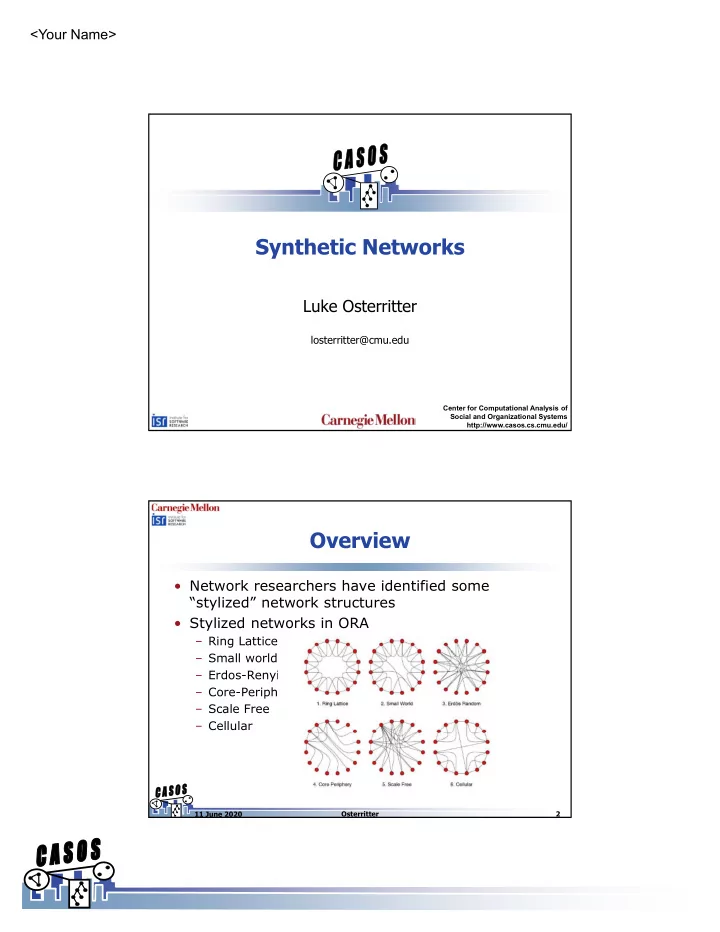

<Your Name> Synthetic Networks Luke Osterritter losterritter@cmu.edu Center for Computational Analysis of Social and Organizational Systems http://www.casos.cs.cmu.edu/ Overview • Network researchers have identified some “stylized” network structures • Stylized networks in ORA – Ring Lattice – Small world – Erdos-Renyi – Core-Periphery – Scale Free – Cellular 11 June 2020 Osterritter 2 1
<Your Name> Why Synthetic Networks? • Synthetic networks generated using random network generators – Easy to obtain – Can vary parameters when running experiments • Real-life (empirical) networks often compared to stylized networks • Have characteristics of real social networks – Clustering – Degree distribution 11 June 2020 Osterritter 3 Structural metrics: Average path length Slide by Kraemer & Barabasi, Bonabeau (SciAm’03) 11 June 2020 Osterritter 4 2
<Your Name> Structural Metrics: Clustering coefficient Slide by Kraemer & Barabasi, Bonabeau (SciAm’03) 11 June 2020 Osterritter 5 ORA – Getting Started 11 June 2020 Osterritter 6 3
<Your Name> Erdos-Renyi (Random) • Purely random • Most common form studied • Properties – Simplest network – Short distances – No local structure (clustering) (till a threshold) – Very different than real-world networks – Rich theory, explains small diameter and giant component 11 June 2020 Osterritter 7 Erdos-Renyi • Purely random • Most common form studied • Properties – Short distances – No local structure – Very different than real-world networks 11 June 2020 Osterritter 8 4
<Your Name> Erdos-Renyi • Input: approx. density of resulting network Approximate density of resulting network 11 June 2020 Osterritter 9 Erdos-Renyi • Input: approximate density of resulting network Approximate density of resulting network 11 June 2020 Osterritter 10 5
<Your Name> Erdos-Renyi 11 June 2020 Osterritter 11 Erdos-Renyi – bi-modal 11 June 2020 Osterritter 12 6
<Your Name> Erdos-Renyi – bi-modal 11 June 2020 Osterritter 13 Erdos-Renyi Notes • Most common form studied • Statistical tests to decide if your network is random • Easy to generate • Good mathematical properties • Very different than real world networks 11 June 2020 Osterritter 14 7
<Your Name> Ring Lattice • Nodes laid out in a circle and connected to their K-closest neighbors • Properties – High clustering – High average path length 11 June 2020 Osterritter 15 Ring Lattice • Number of agents: network size • Number of neighbors: number of neighbors each node is connected to 11 June 2020 Osterritter 16 8
<Your Name> Ring Lattice 11 June 2020 Osterritter 17 Small World • Three Steps – Begin with a lattice, e.g. 2D grid with k-nearest neighbors connected – Randomly remove connections – Randomly add long-distance connections • Properties – High local structure (clustering) – Short maximum distances Examples: Telephone call graphs, electric power grids 11 June 2020 Osterritter 18 9
<Your Name> Small World • Number of neighbors: Dimensionality of embedding space/lattice. Alternatively, average degree. • Probability of removing a neighbor: Remove any local structure? • Probability of adding a neighbor: Add long-range connections? • Power law exponent: How much should long-range connections ignore local structure? How far should they be? 11 June 2020 Osterritter 19 Small World 11 June 2020 Osterritter 20 10
<Your Name> Core-Periphery • Two kinds of nodes – Core of interconnected nodes – Periphery of pendants with single connection to Core • Properties – Short distances – Some local structure (core vs non-core) Examples: Observed trade flows, diplomatic ties among countries 11 June 2020 Osterritter 21 Core-Periphery • Proportion of core nodes • Density of core nodes: How dense should the within- core network be? 11 June 2020 Osterritter 22 11
<Your Name> Core-Periphery 11 June 2020 Osterritter 23 Cellular • Small number of tight clusters with few links between clusters • Properties – Large distances – High local structure (clustering) Examples: Terrorist networks 11 June 2020 Osterritter 24 12
<Your Name> Cellular • Number of cells: How many cells? • Inner Density: how dense should the network within each cell be? • Outer Density: how dense should connections between cells be? 11 June 2020 Osterritter 25 Cellular 11 June 2020 Osterritter 26 13
<Your Name> Scale-Free Networks – Degree Distribution 11 June 2020 Osterritter 27 Scale-Free • Process – Some initial network – New nodes more likely to connect to existing nodes with high degree • Properties – Short distances – No local structure Examples: Social networks, Computer networks (WWW) 11 June 2020 Osterritter 28 14
<Your Name> Scale-Free • How likely is it for new nodes to connect to the core? • Initial node count: How big should the initial network be? • Initial density: How dense should the initial network be? 11 June 2020 Osterritter 29 Scale-Free 11 June 2020 Osterritter 30 15
<Your Name> Summary • Erdos-Reny networks – Random network, IID links • Ring Lattice – Circle layout, k-closest neighbors • Scale free – The degree distribution obeys a power law • Small-world – Ring with a few extra hubs • Cellular – Highly connected cells connected by a link to few other cells • Core periphery – Single strong component with high level of peripherals 11 June 2020 Osterritter 31 Summary 11 June 2020 Osterritter 32 16
Recommend
More recommend